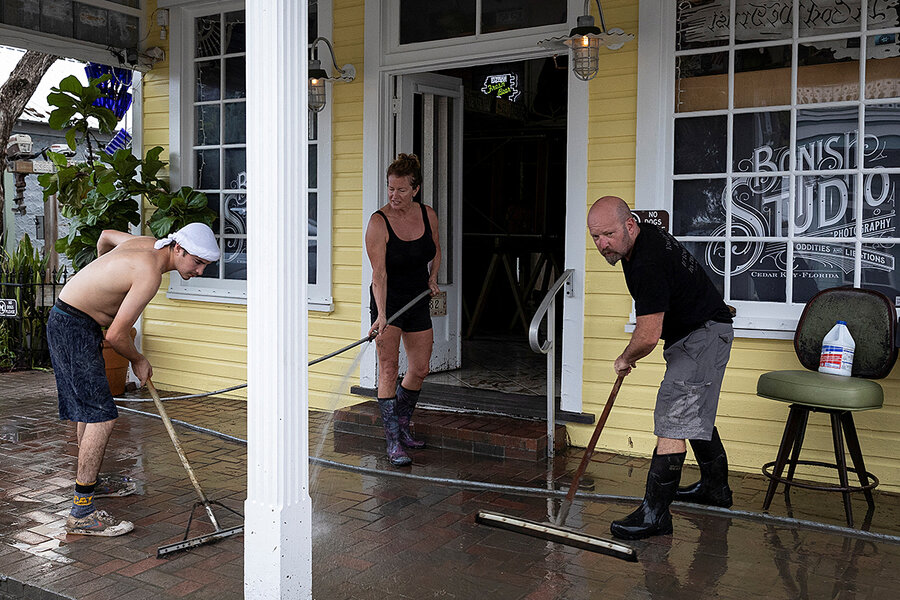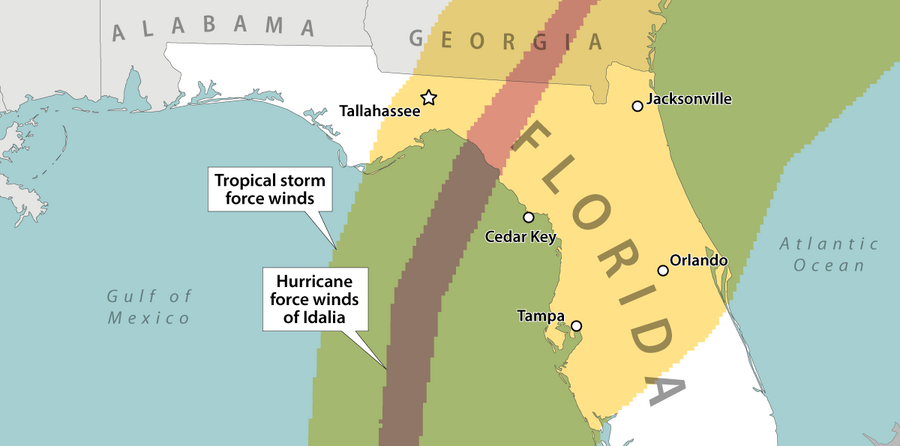Hurricane Idalia tests resilience of Florida’s Nature Coast
Loading...
| Cedar Key, Fla.
This week, one of Florida’s least-developed coastal regions was sorely tested, as Hurricane Idalia flooded coastal and riverside towns, and knocked out power for hundreds of thousands along a path that included southern Georgia.
In the island village of Cedar Key, oriented toward nature and the shellfish industry, most of the roughly 700 residents heeded evacuation orders. Idalia’s storm surge sent waves rolling chest-deep into some of the buildings.
Why We Wrote This
A story focused onThe coastal village of Cedar Key has an “Old Florida” identity. It is also having to adapt to new risks, as hurricane season combines with rising sea levels.
But the storm’s toll on the local clamming industry remains to be tallied. Numerous buildings will need major repairs. And the storm has served notice that even as this island enlists natural solutions such as “living shorelines” to defend itself, it faces ongoing risks due to rising sea levels, warming water temperatures, and intensifying storms.
On Thursday, scenes of recovery were unfolding across the island. Road crews worked to clear downed trees and power lines. Residents were returning to check on their property and each other. Piles of debris began to form outside flooded homes and businesses.
“You know,” says local museum director Anna White Hodges, “there’s one thing about Cedar Key history, and that is the word resilience.”
In the hours before Hurricane Idalia swept through Florida’s Big Bend region, flooding towns and knocking out power for hundreds of thousands, residents of Cedar Key were thinking back to the last time the area was struck by a storm of this magnitude.
The year was 1896, and the tiny barrier island had taken a direct hit. Winds reaching 125 mph and a 10.5-foot storm surge wrecked buildings on Cedar Key and nearly leveled the town on the neighboring island of Atsena Otie.
This week, this scenic region – which is developed so little that it is known as Florida’s Nature Coast – was sorely tested again. Most of Cedar Key’s 700 residents heeded evacuation orders ahead of Category 3 Idalia, whose storm surge sent waves rolling chest-deep into some of the buildings.
Why We Wrote This
A story focused onThe coastal village of Cedar Key has an “Old Florida” identity. It is also having to adapt to new risks, as hurricane season combines with rising sea levels.
But even as residents have stayed safe, the storm’s toll on an important local industry, shellfish, remains to be tallied. Numerous buildings will need major repairs. And the storm has served notice that even as this island enlists natural solutions such as “living shorelines” to defend itself, it faces ongoing risks due to rising sea levels, warming water temperatures, and intensifying storms.
What Cedar Keyans have going for them, as they deal with Hurricane Idalia’s wreckage, is that they show no signs of losing heart.
“I was here during [2016 Hurricane] Hermine, and I saw what it did to the town, and we worked our butts off,” says Mike Allen, director of the Nature Coast Biological Station, a University of Florida research center located on Cedar Key. “The only thing that gives me a little bit of peace about this one is I’ve seen it before, and I’ve seen how fast this community responds. We’ll clean it up, and if you come here eight weeks from now, you’ll be amazed.”
Hurricane Idalia made landfall early Wednesday morning in Keaton Beach, Florida, about 50 miles north of Cedar Key. It unleashed devastating flooding, plus 125 mph winds, in parts of the Big Bend – the region where the Gulf of Mexico coastline arcs southward from Florida’s panhandle. Buffered by its slight distance from the storm’s center, Cedar Key was spared from the worst-case scenario. Wind speeds topped out at about 60 mph – tropical storm speeds – and the storm surge reached about 7 feet, enough to cause significant flooding and structural damage in many parts of the island, but leaving buildings on higher elevation mostly unscathed.
On Thursday, scenes of recovery were unfolding across the island. Road crews worked to clear downed trees and power lines. Power was restored in the early hours of the morning; the water was turned on again later that day (although a boil-water notice has been issued). Evacuated residents were returning to check on their property and each other. Piles of debris began to form outside flooded homes and businesses.
Clams at risk
Longtime Cedar Keyans know the drill. Although Idalia was the worst storm to rake the island in living memory, its residents have lived through other bad storms, and they say their community pulls together quickly after such a disaster. But it’s not just the damage on land that they have to contend with – there’s also the damage that may be hiding underwater.
The tiny size and sleepy nature of Cedar Key belies its outsize role in Florida’s aquaculture industry. It produces an estimated 90% of the state’s clams, harvesting about 90 million clams annually and generating $35 million in revenue.
But hurricanes can represent a major threat to local clam farmers, particularly the mom and pop operations that are still common in Cedar Key. Forceful currents can knock the clams from the seafloor, where they like to nestle into the mud and sand, and cause them to wash away. Freshwater in the form of rain dumped from the storm and increased discharge from the area’s rivers can also harm clams, which are sensitive to water salinity levels as well as to warming water temperatures.
“Two of the main stressors for clams are too much freshwater and too much heat,” says Dr. Allen at the biological research station. “My concern in a storm like this is, you’ve got clams that are already stressed because the water temperature is 90 degrees [Fahrenheit]. We’ve had a fairly wet summer, so there’s a lot of freshwater around, and then you add a tropical storm on them. It could put them over the edge.”
It is still too early to assess clam mortality rates, or see how many clams were uprooted and lost in the storm, says Dr. Allen, since most clammers have not been able to get out on the water to visit their beds.
“It will be several days before a clear picture emerges on impact, but most likely it will not be good,” Leslie Sturmer, a shellfish expert who works for the University of Florida’s Extension Office, writes in an email.
Undeveloped coastlines, but rising seas
One thing clam farmers may not have to worry about, though, is being shut down by the Florida Department of Agriculture and Consumer Services for safety reasons relating to water quality. Coastal waters can become contaminated after large storms due to increased runoff and toxic spills from urban areas. But the stretch of coast where Cedar Key is located is relatively undeveloped compared to the rest of Florida. It has some of the most pristine water in the state, which is necessary for a thriving aquaculture industry. The shellfish, in turn, do their part to keep the water clean: Clams can filter up to 40 gallons of water a day, helping support aquatic ecosystems such as seagrass beds, which can also absorb vast quantities of carbon dioxide.
“This part of Florida is one of the most undeveloped, natural, pristine coastlines that we have,” says Dr. Allen, “and it serves as a really good study site for understanding how Florida systems should function when they’re not heavily impacted by altered water flow and heavy use of fertilizer and lots of development and those kinds of things.”
The environment and aquaculture are closely linked on Cedar Key: What benefits one benefits the other. Residents have worked hard over the years to protect their water, fighting off local development proposals, voluntarily eliminating septic tanks on the island, and educating locals and visitors alike about the importance of healthy waters.
But the island faces the risk of storms made increasingly powerful by climate change, as well as the quieter but no less dire threat of rising seas. The local sea level has risen almost 6 inches since 1992, and in 2020 Cedar Key recorded the fourth-highest rate of sea-level rise acceleration in the nation.
Speaking to a local newspaper in 2017, City Commissioner Sue Colson said efforts to stave off the effects are important, but “we should ... not make the investment too high so that you don’t go broke fighting the inevitable.”
Focused now on maintaining their lives and livelihoods here, locals are keeping their perspective, including their sense of humor.
Sheltering a history
A block away from the biological station, at the Cedar Key Historical Society Museum, Executive Director Anna White Hodges had secured artifacts before the storm so that they stayed high and dry. On Thursday, she is already starting to move some items back into their cases.
“This is the historical museum,” she tells a television reporter peeking through the open front door, “and we’re making history today. We’ve just added another hurricane.”
Ms. Hodges proudly shows how little damage the museum’s interior suffered, slipping into a practiced tour guide mode as she moves through the rooms. She pauses to whip open a door, revealing a bathroom with an 1800s-era ship buoy perching on the toilet seat.
“That was the only thing I could find that could hold it,” she says. “I’m like, ‘I hate doing this to you, buddy. But you’re going in.’”
As she moves through the rest of the museum, pointing out exhibits and artifacts that trace the island community’s many comebacks over the years from weather-related disasters, as well as environmental and economic setbacks, it becomes clear that Ms. Hodges has a theme on her mind.
“You know,” she says, “there’s one thing about Cedar Key history, and that is the word resilience.”










